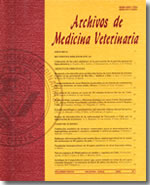Leptospirosis. Las aguas de la explotación porcina como vehículo de la Leptospira, en la zona central cafetera de Colombia
Contenido principal del artículo
Resumen
Este trabajo se realizó en 15 explotaciones porcinas de la zona central cafetera, donde se corroboró la presencia de bacterias leptospiraceae en las diferentes fuentes de agua existentes, mediante examen directo (Campo oscuro) y cultivos en medio EMJH (DIFCO) semisólido utilizando filtración con membranas Milipore 0.22 y 0.45µ. Se tomaron 292 muestras de aguas, que se utilizan para consumo y lavado, de las cuales 60 fueron positivas para leptospira, 20.5% (60/292) por visualización directa y 47 aguas servidas, de las cuales 66% (31/47) fueron positivas. El orden de importancia en cuanto a tasa proporcional de contaminación fue: aguas servidas, tanque de almacenamiento, chupones bebederos y tanque de lavado. La positividad de cultivos para leptospira, fue como sigue: en aguas para consumo y lavado 14.2% y 9.3% en aguas servidas. La tasa proporcional más alta de contaminación por leptospiraceae, en las aguas de consumo y lavado, lo presentaron los tanques de almacenamiento y los chupones bebederos. Las aguas servidas presentaron una alta positividad por microscopía de campo oscuro, pero una positividad baja en cultivo. Las 17 cepas obtenidas como producto del trabajo, al igual que los antígenos de referencia: pomona, icterohaemorragiae, grippotyphosa, canícola, bratislava, hardjobovis y hardjopratjino que fueron enfrentados en la MAT, a 68 sueros de porcinos de las explotaciones, fueron negativos. Finalmente, las 17 cepas obtenidas no pudieron ser clasificadas ni como L. interrogans, ni como L. biflexa, considerándose que podrían ser leptospiras intermedias, entre saprofitas y patógenas.

